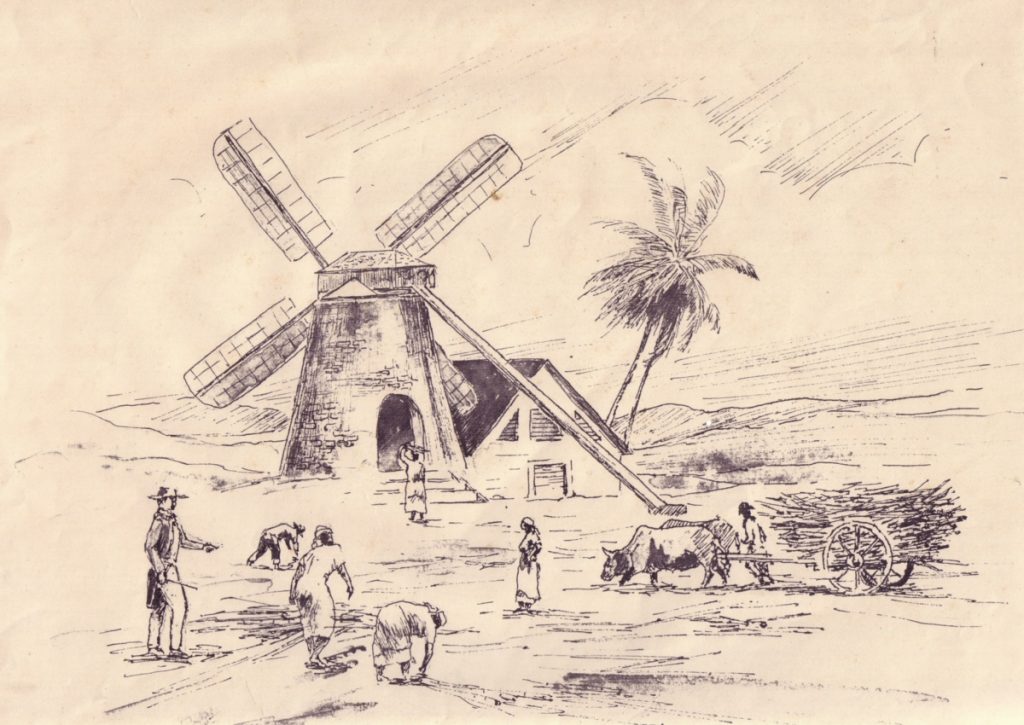About
Type: Ruin
Parish: St.Peter
Founding date: 1690
See on Google Maps!

Current Status
There is no longer a mill at this site and in fact anything that would remind one of this once thriving estate. If any worked stones exist they have been mingled with those of the hills and fields.
“Upper Freeman’s at the family burial-ground in a cane piece, and under a large bread-fruit tree on a ledger, over a stone vault: Maj. John Wickham and Elizabeth Wickham.” These are the two MI’s at the southwestern base of Mt. Joy which must have been part of Freeman’s estate. Freemans Village is where Papa Sammy, of “To Shoot Hard Labour” fame, came from. The village got its name from the estate owner, Freeman, and not from freed slaves when villages were built after emancipation, i.e. Freetown and Liberta.
Estate Related History/timeline
1700: John Slicer died leaving his plantations to only child Mary Slicer who md. Robert Freeman.
1706: “Petition of Arthur Freeman, an Ex’or in Trust for Robert Freeman of Antigua, infant, reciting that John Slicer of Antigua owned several plantations, and died leaving them to his only child Mary Slicer, whom Robert Freeman married, and improved said lands. They, by Act dated 24 Dec., 1700, were empowered to sell portion of the lands. Robert Freeman is dead, leaving an only child and infant Robert Freeman. Mary, widow of Robert Freeman, is married to one Perne, who threatens the purchasers of the said land. Dated 14 Feb., 1706-07.” V.Oliver Vol.I p.266
1724: “Freeman was born in 1724 and died January 30, 1780 aged 56. In 1765, when forty-one years old he eloped with the youngest daughter of the Governor, George Thomas, and went to England. The Governor was so angry with Freeman for running off with his daughter, at that time nineteen years old, he suspended him from Council.” Journal by a Lady of Quality by Janet Schaw p.101.
1779: “Arthur Freeman’s Plantation contained 360 acres given to Marmaduke Robinson.” As the Freeman’s tended to be absentee landowners, it is possible that it was given to him to manage or lease.
1852: Freemans Lower contained 365 acres and was owned by Inigo Thomas. Inigo Freeman Thomas 1767-1847 was an MP and absentee slave-owner, awarded compensation with his brother-in-law for the Lower Freeman’s estate in Antigua and claimed as tenant-for-life of two other estates in Antigua (Winthrope’s (#56) and Galley Bay (#30), the compensation for which was paid to his son Freeman Thomas (q.v.) Born Inigo Freeman, adopted the name Thomas in 1789 after inheriting the Thomas family estates both at Ratton in Willingdon and at Yapton in West Sussex. Biography Inigo Freeman Thomas
MP and absentee slave-owner, awarded compensation with his brother-in-law for the Lower Freeman’s estate in Antigua and claimed as tenant-for-life of two other estates in Antigua (Winthrope’s and Galley Bay), the compensation for which was paid to his son Freeman Thomas (q.v.). Born Inigo Freeman, adopted the name Thomas in 1789.
1833: In 1833 Parliament finally abolished slavery in the British Caribbean, Mauritius and the Cape. The slave trade had been abolished in 1807 but it took another 26 years to effect the emancipation of the enslaved. The legislation of 1833 was the result of a combination of factors where it was felt that the plantation owners should be compensated for their slaves who were to be freed. The amount of 20 million pounds , a huge amount in those days, was divided up between all slave owners.
John Broderick – absentee/resident – awardee 336 – Antigua (Lower Freeman’s) view -1246 £2,019 lbs 4 s 3 d (122 enslaved).
1851: The Antigua Almanac shows Freeman’s Lower of 365 acres belonging to Inigo Thomas In 1852, this Estate contained 365 acres and 127 slaves.
1878: Antonio Joseph Camacho (d.1894) arrived in Antigua from Madeira in the late 1860’s and by 1871 owned A.J. Camacho & Co., an export and merchant business. His son Emanuel O. Camacho inherited the business and was the sole owner in 1918. He owned Briggin’s (22), Herbert’s (20) and Dunning’s (#190) estates between 1871 and 1878 and Jonas (#85), Otto’s (#16) and Langford’s (6) between 1878 and 1891. By 1897, he also owned Wood’s (#12), Lower Freeman’s (#81b) and Oliver’s (#201). By the time he died in 1894, he had over 1600 acres of sugarcane under cultivation and the single largest landowner besides the Maginley family. He was a staunch supporter of the Catholic Church. Martin J. Camacho is listed as part proprietor to his father’s estates in 1898.
Enslaved People’s History
Based on contemporary research, we have little information to share about the enslaved peoples from this plantation at this time. We only know that Lower Freeman’s was awarded £2,019 4 s 3 d for the liberation of 122 enslaved people after the abolition of slavery in the Caribbean. We will continue our quest for more information about these vital individuals.
Legacies of British Slave-ownership claimants: Freeman’s was awarded £2,019 lbs 4 s 3 d for 122 enslaved. Hon. John Brodick was the awardee, Inigo Freeman Thomas was unsuccessful.
Ownership Chronology
- 1690: John Slicer. d.1700.
- 1730: Robert Freeman. Married Mary Slicer, only child of John Slicer. 2nd marriage to John Pearne.
- 1760: Arthur Freeman. b . 1724; d1780. Married Margaret, youngest daughter of Sir GeorgeThomas.
(1777/78 Luffman map) - 1779: Inigo Thomas. b. 1767; d.1847. 122 slaves.
- 1843: Inigo Freeman Thomas. Changed his name to Thomas in 1789. 1851 Horsford Almanac
- 1872: Mrs. Peter. Also 94 acres in St. George’s Parish.
(1872 Horsford Almanc) - 1878: W. A. Parker & Co.
- 1891: Antonio Joseph Camacho. d. 1894.
(1891 Henry Martin Adams map) - 1933: Martin J. Camacho. 1933 Camacho map
- 1943: Antigua Syndicated Estates, Ltd. (ASE).
- 1968: Antigua Government – Crown Land.